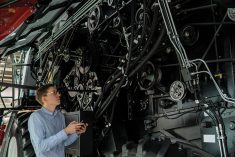Along with winter comes the increased risk of carbon monoxide poisoning. The danger not only exists in homes with natural gas furnaces but also in barns, sheds, garages or workshops that have fuel-powered heating systems or where work is being performed with internal combustion engines. Many people using equipment like compressors, generators, welders and even pumps inside buildings or in semi-enclosed spaces have been poisoned by carbon monoxide.
Carbon monoxide is a byproduct of incomplete combustion. There is always some produced whenever any carbon-based fuel, such as natural gas, heating oil, wood, reconstituted wood logs, gasoline, charcoal or any similar product, is burned. Colourless, odourless and tasteless, this highly toxic gas is undetectable to the human senses, making it the perfect killer.
Read Also

Gentle treatments for pain in the neck
Heading toward year-end, people unknowingly tense up against the cold and busyness, causing neck pain that can often be treated with appropriate support and gentle mobility, athletic therapist Kathlyn Hossack says.
Carbon monoxide enters the body through the lungs during the normal breathing process. It replaces oxygen in the blood and prevents the flow of oxygen to the heart, brain and other vital organs. When you inhale carbon monoxide, it reduces your body’s ability to carry oxygen in your blood. The health effects can be serious, even resulting in death. It is important to note carbon monoxide is dangerous at any level. Even low exposure can result in damage to your health.
Symptoms of carbon monoxide poisoning are very much like the flu, but with no fever. You become nauseous, may experience a headache and become lethargic. Carbon monoxide poisoning can also cause chest pain, dizziness, shortness of breath, confusion and drowsiness.
Of course, on the farm, just because it is cold outside does not mean work stops. Often repairs on machinery like tractors take place during the cold months when work in the field has stopped. Sometimes this means using a generator or compressor or even idling a piece of equipment inside. However, all of these activities produce carbon monoxide, which can rapidly accumulate and build up to dangerous or fatal concentrations within minutes.
What is the best way to prevent carbon monoxide poisoning?
Unless your building is designed with a proper mechanical ventilation system, avoid running gas-powered equipment inside. If you do have to run a machine or tool inside a building that is not designed with a mechanical ventilation system, ensure there is adequate air ventilation. If you’re working in a shed, for example, make sure the shed door is open and there’s also a door open at the other end of the building. Your best bet though is to avoid running gas-powered equipment like generators inside the building at all.
It is also essential when you’re outside to operate gas-powered equipment and machines away from windows, doors and vent openings so fumes cannot enter buildings through these areas. Avoid idling tractors, trucks and other vehicles inside garages and sheds. Even with the overhead door open, carbon monoxide can quickly build up if the area is not properly ventilated.
If you suspect you or someone else has been exposed to carbon monoxide, evacuate the area and call emergency services. If you suspect your home has a carbon monoxide leak somewhere, do not open the windows or try to ventilate the area. Emergency responders will be able to locate the source of the emissions, like a blocked chimney or a faulty water heater, more quickly and accurately.
If your home, garage, shop or barn is heated with natural gas, propane or other fuels, ensure you have working carbon monoxide alarms. All heating appliances should also have regular maintenance, and ventilation should also be checked, ensuring it is not blocked by snow or other debris like leaves.
Carbon monoxide is not always at the top of our minds when it comes to safety, but it is a leading cause of accidental poisoning deaths in Canada. Prevention is the key to stopping these deaths. Installing and maintaining carbon monoxide alarms, running machinery and equipment outside in an unobstructed, well-ventilated area and maintaining distance from windows, doors and vent openings will prevent unintentional exposure to this deadly poison.
For more information about farm safety, visit the Canadian Agricultural Safety Association website.















